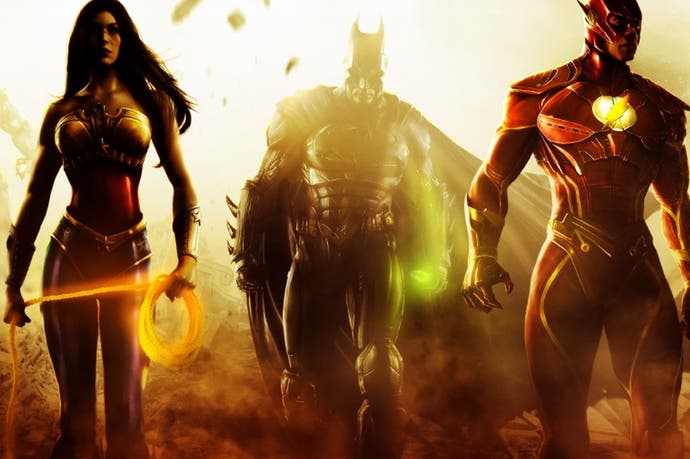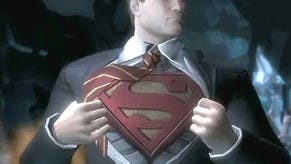Injustice: Gods Among Us review
Suit up, crime!
When pioneering fighting games like Street Fighter and Tekken first showed up in western arcades all those years ago, each cabinet earned more than its weight in 20 pence pieces thanks to the solidity of their fighting mechanics. There were no combo trials or challenge towers to distract yourself with - only the gradual discovery of your character's hidden depths through a steady flow of opponents, be they human or otherwise. Even today, this hook keeps diehard enthusiasts coming back for more, but as the genre evolved alongside the console market one thing has become increasingly clear: single-player content can no longer be seen as an optional extra.
The problem is that fighting games tend to come in two different forms. Either they have excellent mechanics with a basic survival mode and a flimsy storyline or they push the boat out in terms of game modes while neglecting the underlying systems. There are notable exceptions like BlazBlue, of course, but why is the union of mechanical depth and solo mileage such a hard combination to crack? NetherRealm Studios almost solved the conundrum with Mortal Kombat, a reboot that backed up its cinematic story mode with competent combat. But now that the team has ditched Nightwolf in favour of Nightwing, has it finally hit the sweet spot?
Just like Mortal Kombat before it, Injustice: Gods Among Us features a Story Mode that puts most other fighting games to shame. With the aid of Lex Luthor, The Joker gets hold of a nuclear bomb, rigs the detonator to Lois Lane's heart (she's also pregnant) and tricks Superman into killing her by making him think she's Doomsday. Understandably miffed, Superman kills The Joker before setting up a new world order where his word is law. Batman then summons superheroes from another dimension - one where The Joker didn't succeed - so he can put a stop to The Man of Steel's tyranny.

As far as comic book capers go this one is a bit on the sporadic side, but to NetherRealms credit, the story manages to accommodate all 24 characters without feeling too disjointed. And while there's far less blood than you'd expect from the Kombat custodians, the game still conveys a sense of darkness that goes beyond the traditional hero versus villain dynamic. The only real regret is that The Joker never comes into contact with an alternate version of himself, but aside from this missed opportunity, the seven hour completion time offers an engaging story with around 50 fights in total.
On top of Story mode there's also Battles, S.T.A.R.S. Labs and Training. Battles is the obligatory arcade mode but with 20 different paths that range from playing as a random character every single match to defeating every character with just a single health bar. The Training room, meanwhile, is stocked with all the usual suspects like dummy settings and playback functions but goes the extra mile with comprehensive frame data. And last but by no means least, S.T.A.R.S. Labs is the stand-in for Mortal Kombat's challenge tower with 240 missions that each have a primary objective and two secondary objectives.
To say that Injustice has a lot of single player content would be an understatement. If your ISP went down tomorrow and you had to spend a week without the internet, then trying to three star every mission alone would give you plenty to think about. That said, a fighting game will always live or die by the sophistication of its fighting system. When you set up the perfect opportunity for a complex combo you need to feel like you outplayed your opponent. You also need a roster of characters that offer many different play styles, and in this regard, Injustice feels like a well-rounded package.

The DNA is an evolution of the Mortal Kombat template but with a number of significant changes. The most obvious is the removal of the block button. The game adopts a Street Fighter approach where you simply hold back to shrug off an oncoming assault. This means that cross-ups now play an important part as you have to guess which side your opponent will hit when they jump on you. Another interesting change is the Darkstalkers-style round system. This works the opposite way to a comeback mechanic, as when one player loses all their health before entering the next round, the other player retains all the health they had remaining.
It's a style of engagement that rewards you for dominating your opponent and makes unprecedented comebacks less likely. You don't speed up, become enraged or gain access to a show-stopping super attack just because you're losing. You have to earn each victory. The game uses five primary buttons that include a light, medium and heavy attack in addition to a dedicated Meter Burn button that lets you perform advanced techniques like EX specials and push blocks. There's even an unorthodox Clash system that works like a combo breaker where you can wager metre. If the defending player wins they gain health but if they lose they take additional damage.
Needless to say, meter management is a huge part of what makes Injustice tick, but in terms of etching out a distinctive style of engagement, the Power button and Interactive Objects are this game's killer hook. The Power button works similarly to BlazBlue's Drive system by complimenting each character with a unique ability that goes beyond the standard special moves. Wonder Woman can switch between her sword and shield stances; The Flash can activate a slow motion effect; and Bane can increase his damage output at the cost of a hefty cool-down period. These inherent systems make an already versatile game feel even more distinctive.

The final piece of the puzzle is the Interactive Objects system. Traditionally, 2D fighting games tend to stick to static arenas with an invisible wall at either end. Injustice bucks this trend by furnishing each stage with a handful of useable items that include grenades in the Batcave and a turret on Stryker's Island. It sounds a bit Power Stone-esque, but these objects add an extra dimension to the mind-games, and it's one that's less cheap and more tactical. They also make stage selection an important part of the meta-game as power-type character like Doomsday use objects differently to a gadget or acrobatic character like Green Arrow or Harley Quinn.
So yes, mechanics and content can make or break a modern fighting game, and Injustice delivers on those fronts. There is, however, a third element which is equally important, and that's online stability. The netcode that governed Mortal Kombat left a lot to be desired, and although the team have had two years to reduce the impact of input latency, the improvements appear to be marginal rather than game changing. To be fair, my online experience has been predominantly against US opponents in the Ranked and Player Matches, but it's clear that NetherRealm is lagging behind the likes of Arc System and Reverge Labs in this regard.
It's definitely not the worst online rodeo I've ever been invited to, and on all other accounts Injustice is the complete package. From the way that Catwoman prowls back and forth with her feline dexterity to Harley Quinn's mischievous movements as she brandishes her twin revolvers, the game exhibits an attention to detail that does justice to every DC character. Even the more outlandish creations - like Solomon Grundy with his zombie-style attacks - have been animated to a particularly high standard.
One question you might ask yourself is whether Injustice is better than the likes of Tekken Tag Tournament 2 or Street Fighter 4. If anything, NetherRealm have crafted a fighting game experience that's less concerned with which is "better" and more with which style of combat you prefer. A more relevant question would be which fighting game caters for the most types of players - be they arcade stick veterans, casual fighter fans or players who just want to have something to do once arcade mode is finished. All we can say is that Injustice offers justice for all.







